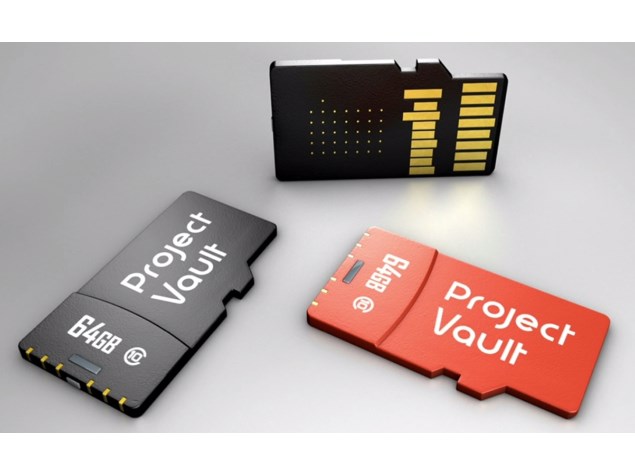- Home
- Mobiles
- Mobiles News
- Google's Project Vault Puts a Secure, Encrypted Computer Inside a microSD Card
Google's Project Vault Puts a Secure, Encrypted Computer Inside a microSD Card

The fingernail-sized device runs on a custom ARM processor and has 4GB of secure storage space. It runs its own security-centric real-time OS with built in cryptographic infrastructure including a suite of encryption services and a hardware random-number generator. It has its own NFC hardware including an antenna, which can be used to authenticate users based on a physical token in their possession. The microSD interface suffices for all data input and output.
Google claims the Vault is completely transparent to its host devices and shows up as any ordinary storage destination. It is completely device- and OS-agnostic and only needs to be plugged in to work. Compatible apps can interact with two dedicated files: one that must be written to and the other that can only be read from. The rest of its file system is fake, and any interaction with it will result in a standard "bad sector" error, preventing even the host device from seeing what goes in and out of the Vault. No special drivers or user intervention are required. This means that a user's security is maintained even if he or she moves the Vault between multiple host devices, no matter how insecure they might be.
The device and its software support text messaging, voice, and video streaming, as long as parties on both ends have their own Vault cards. Immutable hardware logging features would help owners determine if anyone has tried tampering with their Vault. Google is using 500 prototype cards internally and hopes to have commercial products out soon, with enterprise customers targeted first and consumer applications rolling out later. An open-source kit including development hardware and source code is already available.
Get your daily dose of tech news, reviews, and insights, in under 80 characters on Gadgets 360 Turbo. Connect with fellow tech lovers on our Forum. Follow us on X, Facebook, WhatsApp, Threads and Google News for instant updates. Catch all the action on our YouTube channel.
Related Stories
- Samsung Galaxy Unpacked 2025
- ChatGPT
- Redmi Note 14 Pro+
- iPhone 16
- Apple Vision Pro
- Oneplus 12
- OnePlus Nord CE 3 Lite 5G
- iPhone 13
- Xiaomi 14 Pro
- Oppo Find N3
- Tecno Spark Go (2023)
- Realme V30
- Best Phones Under 25000
- Samsung Galaxy S24 Series
- Cryptocurrency
- iQoo 12
- Samsung Galaxy S24 Ultra
- Giottus
- Samsung Galaxy Z Flip 5
- Apple 'Scary Fast'
- Housefull 5
- GoPro Hero 12 Black Review
- Invincible Season 2
- JioGlass
- HD Ready TV
- Laptop Under 50000
- Smartwatch Under 10000
- Latest Mobile Phones
- Compare Phones
- Realme P4x 5G
- OnePlus Ace 6T
- OPPO A6x 5G
- Samsung Galaxy Z TriFold
- Poco F8 Ultra
- Poco F8 Pro
- Huawei Mate 80 RS Master Edition
- Huawei Mate 80 Pro Max
- Asus ProArt P16
- MacBook Pro 14-inch (M5, 2025)
- Poco Pad M1
- Poco Pad X1
- Just Corseca Skywatch Pro
- Honor Watch X5
- Acerpure Nitro Z Series 100-inch QLED TV
- Samsung 43 Inch LED Ultra HD (4K) Smart TV (UA43UE81AFULXL)
- Asus ROG Ally
- Nintendo Switch Lite
- Haier 1.6 Ton 5 Star Inverter Split AC (HSU19G-MZAID5BN-INV)
- Haier 1.6 Ton 5 Star Inverter Split AC (HSU19G-MZAIM5BN-INV)

















